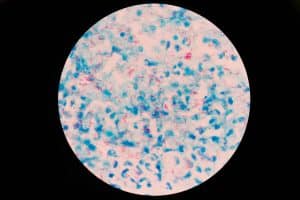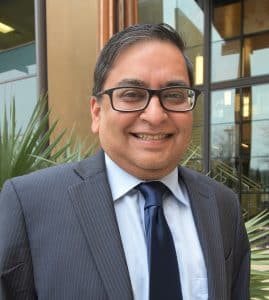
Tuberculosis and HIV – two of the world’s deadliest infectious diseases – are far worse when they occur together. Now, Texas Biomedical Research Institute researchers have pinpointed an important mechanism at work in this troubling health problem. And, their discovery could lead to a new mode of treatment for people at risk. The results were published in the Journal of Clinical Investigation, a top-tier venue for critical advances in biomedical research.
“We were a little surprised at the extent of clarity in our data,” Professor and Southwest National Primate Research Center Director Deepak Kaushal, Ph.D., said. “I am actually very excited to move forward trying different treatment approaches on co-infected monkeys.”
The scientific community has long assumed the reason people with HIV are more likely to develop TB is a depletion of immune cells called CD4+ T cells. However, Dr. Kaushal’s team was able to show that other effects of viral co-infection play a crucial role in this process.
Using about 40 rhesus macaques, researchers determined that lung-specific chronic immune activation is responsible for the progression of disease. Chronic immune activation is a dysfunction of immune pathways that generate molecules (cytokines and chemokines) which fight off pathogens like bacteria, viruses and fungi.
Dr. Kaushal used an analogy to explain what this dysfunction caused by HIV infection does in the body. “It’s like all the taps and faucets in your house are turned on full blast all the time,” he said. “You are going to lose a lot of water. With this dysfunction, all cytokines ad chemokines are constantly being produced to the highest levels. This dysregulates the body’s ability to fight off other infections.”
Even with the gold standard antiretroviral therapy (ART) for people with HIV, chronic immune activation still persists. Dr. Kaushal said his study shows “we need to develop approaches to target chronic immune activation,” perhaps with a drug that would be an additional therapy along with ART.

Dr. Kaushal said the implications of a new method of treatment are enormous. Up to a fourth of the world’s population is infected with tuberculosis. Most of the time, the bacterial disease remains latent (dormant). In otherwise healthy people with latent TB, only 5% will go on to develop active tuberculosis. In HIV/AIDS patients, the risk of developing active TB increases ten-fold to 50%. TB and HIV co-infection is considered a global syndemic, meaning the diseases are pandemics infecting people all around the world, and they promote each other. In parts of Sub-Saharan Africa, the rate of TB/HIV co-infection is “astronomically high,” according to Dr. Kaushal, citing statistics that show it’s 100 times higher than the rest of the world.
This discovery was 12 years in the making, starting with the creation of a nonhuman primate model for TB/HIV co-infection. Dr. Kaushal said he is hopeful new treatment strategies could reach the clinic within a decade.
The first author of the study, Allison N. Buscan, Ph.D., was a graduate student in Dr. Kaushal’s Tulane National Primate Research Center lab, and is currently a post-doc at Uniformed Health Services University in Bethesda, MD. Other Texas Biomed Scientists involved in the study include post-docs Ayan Chatterjee, PhD and Dhiraj K. Singh, PhD and Staff Scientist Tae-Hyung Lee, Ph.D.
This research was funded by a grant from the National Institutes of Health award #AI111914 and #OD011104.